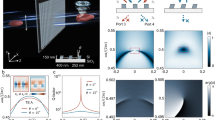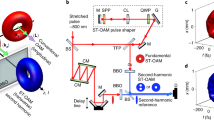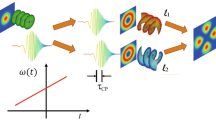Abstract
Spatiotemporal optical vortices (STOVs) are space–time structured light pulses with a unique topology that couples spatial and temporal domains and carry transverse orbital angular momentum (OAM). Up to now, their generation has been limited to the visible and infrared regions of the spectrum. During the last decade, it was shown that through the process of high-order harmonic generation, it is possible to upconvert spatial optical vortices that carry longitudinal OAM from the near-infrared into the extreme-ultraviolet (EUV), thereby producing vortices with distinct femtosecond and attosecond structure. In this work, we demonstrate theoretically and experimentally the generation of EUV spatiotemporal and spatiospectral vortices using near-infrared STOV driving laser pulses. We use analytical expressions for focused STOVs to perform macroscopic calculations of high-order harmonic generation that are directly compared to the experimental results. As STOV beams are not eigenmodes of propagation, we characterize the highly charged EUV STOVs in both the near and far fields to show that they represent conjugated spatiotemporal and spatiospectral vortex pairs. Our work provides high-frequency light beams topologically coupled at the nanometre/attosecond scales domains with transverse OAM that could be suitable to explore electronic dynamics in magnetic materials, chiral media and nanostructures.
This is a preview of subscription content, access via your institution
Access options
Access Nature and 54 other Nature Portfolio journals
Get Nature+, our best-value online-access subscription
27,99 € / 30 days
cancel any time
Subscribe to this journal
Receive 12 print issues and online access
209,00 € per year
only 17,42 € per issue
Buy this article
- Purchase on SpringerLink
- Instant access to full article PDF
Prices may be subject to local taxes which are calculated during checkout




Similar content being viewed by others
Data availability
The simulation dataset that supports the findings of this study is available online via figshare at https://doi.org/10.6084/m9.figshare.28714805 (ref. 67). The experimental data are available upon reasonable request.
Code availability
The simulation and data visualization codes to generate the plots and data analysis within this paper are available from the corresponding authors on reasonable request.
References
Bliokh, K. Y. et al. Roadmap on structured waves. J. Opt. 25, 103001 (2023).
Shen, Y. et al. Roadmap on spatiotemporal light fields. J. Opt. 25, 093001 (2023).
Allen, L., Beijersbergen, M. W., Spreeuw, R. J. C. & Woerdman, J. P. Orbital angular momentum of light and the transformation of Laguerre-Gaussian laser modes. Phys. Rev. A 45, 8185–8189 (1992).
Liu, K. et al. Super-resolution radar imaging based on experimental OAM beams. Appl. Phys. Lett. 110, 164102 (2017).
Nicolas, A. et al. A quantum memory for orbital angular momentum photonic qubits. Nat. Photonics 8, 234–238 (2014).
Zhou, Z.-Y. et al. Orbital angular momentum photonic quantum interface. Light Sci. Appl. 5, e16019 (2016).
Wang, B. et al. Coherent Fourier scatterometry using orbital angular momentum beams for defect detection. Opt. Express 29, 3342–3358 (2021).
Vanacore, G. M. et al. Ultrafast generation and control of an electron vortex beam via chiral plasmonic near fields. Nat. Mater. 18, 573–579 (2019).
Sukhorukov, A. P. & Yangirova, V. V. Spatio-temporal vortices: properties, generation and recording. In Proc. Congress on Optics and Optoelectronics (eds Karpierz, M. A. et al.) 35–43 (SPIE, 2005).
Bliokh, K. Y. & Nori, F. Spatiotemporal vortex beams and angular momentum. Phys. Rev. A 86, 033824 (2012).
Jhajj, N. et al. Spatiotemporal optical vortices. Phys. Rev. 6, 031037 (2016).
Hancock, S. W., Zahedpour, S., Goffin, A. & Milchberg, H. M. Free-space propagation of spatiotemporal optical vortices. Optica 6, 1547–1553 (2019).
Chong, A., Wan, C., Chen, J. & Zhan, Q. Generation of spatiotemporal optical vortices with controllable transverse orbital angular momentum. Nat. Photonics 14, 350–354 (2020).
Huang, S. et al. Spatiotemporal vortex strings. Sci. Adv. 10, eadn6206 (2024).
Wang, H., Guo, C., Jin, W., Song, A. Y. & Fan, S. Engineering arbitrarily oriented spatiotemporal optical vortices using transmission nodal lines. Optica 8, 966–971 (2021).
Huang, J., Zhang, H., Wu, B., Zhu, T. & Ruan, Z. Topologically protected generation of spatiotemporal optical vortices with nonlocal spatial mirror symmetry breaking metasurface. Phys. Rev. B 108, 104106 (2023).
Huo, P. et al. Observation of spatiotemporal optical vortices enabled by symmetry-breaking slanted nanograting. Nat. Commun. 15, 3055 (2024).
Chen, J. et al. Automated close-loop system for three-dimensional characterization of spatiotemporal optical vortex. Front. Phys. 9, 633922 (2021).
Gui, G. et al. Single-frame characterization of ultrafast pulses with spatiotemporal orbital angular momentum. ACS Photonics 9, 2802–2808 (2022).
Huang, S., Wang, P., Shen, X. & Liu, J. Properties of the generation and propagation of spatiotemporal optical vortices. Opt. Express 29, 26995–27003 (2021).
Huang, S., Wang, P., Shen, X., Liu, J. & Li, R. Diffraction properties of light with transverse orbital angular momentum. Optica 9, 469–472 (2022).
Porras, M. A. & Jolly, S. W. Control of vortex orientation of ultrashort optical pulses using a spatial chirp. Opt. Lett. 48, 6448–6451 (2023).
Porras, M. A. Propagation of higher-order spatiotemporal vortices. Opt. Lett. 48, 367–370 (2023).
Porras, M. A. Transverse orbital angular momentum of spatiotemporal optical vortices. Prog. Electromagn. Res. 177, 95–105 (2023).
Chen, J., Yu, L., Wan, C. & Zhan, Q. Spin–orbit coupling within tightly focused circularly polarized spatiotemporal vortex wavepacket. ACS Photonics 9, 793–799 (2022).
Gui, G., Brooks, N. J., Kapteyn, H. C., Murnane, M. M. & Liao, C.-T. Second-harmonic generation and the conservation of spatiotemporal orbital angular momentum of light. Nat. Photonics 15, 608–613 (2021).
Hancock, S., Zahedpour, S. & Milchberg, H. Second-harmonic generation of spatiotemporal optical vortices and conservation of orbital angular momentum. Optica 8, 594–597 (2021).
McPherson, A. et al. Studies of multiphoton production of vacuum-ultraviolet radiation in the rare gases. J. Opt. Soc. Am. B 4, 595 (1987).
Ferray, M. et al. Multiple-harmonic conversion of 1064 nm radiation in rare gases. J. Phys. B 21, L31–L35 (1988).
Schafer, K. J., Yang, B., Dimauro, L. F. & Kulander, K. C. Above threshold ionization beyond the high harmonic cutoff. Phys. Rev. Lett. 70, 1599–1602 (1993).
Corkum, P. B. Plasma perspective on strong field multiphoton ionization. Phys. Rev. Lett. 71, 1994–1997 (1993).
Rundquist, A. et al. Phase-matched generation of coherent soft X-rays. Science 280, 1412–1415 (1998).
Popmintchev, T. et al. Bright coherent ultrahigh harmonics in the keV X-ray regime from mid-infrared femtosecond lasers. Science 336, 1287–1291 (2012).
Hernández-García, C., Picón, A., San Román, J. & Plaja, L. Attosecond extreme ultraviolet vortices from high-order harmonic generation. Phys. Rev. Lett. 111, 083602 (2013).
Gariepy, G. et al. Creating high-harmonic beams with controlled orbital angular momentum. Phys. Rev. Lett. 113, 153901 (2014).
Géneaux, R. et al. Synthesis and characterization of attosecond light vortices in the extreme ultraviolet. Nat. Commun. 7, 12583 (2016).
Hernández-García, C. et al. Extreme ultraviolet vector beams driven by infrared lasers. Optica 4, 520–526 (2017).
Dorney, K. M. et al. Controlling the polarization and vortex charge of attosecond high-harmonic beams via simultaneous spin–orbit momentum conservation. Nat. Photonics 13, 123–130 (2019).
Kong, F. et al. Controlling the orbital angular momentum of high harmonic vortices. Nat. Commun. 8, 14970 (2017).
Gauthier, D. et al. Tunable orbital angular momentum in high-harmonic generation. Nat. Commun. 8, 14971 (2017).
Rego, L. et al. Generation of extreme-ultraviolet beams with time-varying orbital angular momentum. Science 364, eaaw9486-10 (2019).
de las Heras, A., San Román, J., Serrano, J., Plaja, L. & Hernández-García, C. Circularly polarized high-harmonic beams carrying self-torque or time-dependent orbital angular momentum. ACS Photonics 11, 4365–4373 (2024).
Rego, L. et al. Necklace-structured high-harmonic generation for low-divergence, soft x-ray harmonic combs with tunable line spacing. Sci. Adv. 8, eabj7380 (2022).
Heras de las et al. Attosecond vortex pulse trains. Optica 11, 1085–1093 (2024).
Wang, B. et al. High-fidelity ptychographic imaging of highly periodic structures enabled by vortex high harmonic beams. Optica 10, 1245–1252 (2023).
Vincenti, H. & Quéré, F. Attosecond lighthouses: how to use spatiotemporally coupled light fields to generate isolated attosecond pulses. Phys. Rev. Lett. 108, 113904 (2012).
Wheeler, J. A. et al. Attosecond lighthouses from plasma mirrors. Nat. Photonics 6, 829–833 (2012).
Kim, K. T. et al. Photonic streaking of attosecond pulse trains. Nat. Photonics 7, 651–656 (2013).
Hammond, T. J., Brown, G. G., Kim, K. T., Villeneuve, D. M. & Corkum, P. B. Attosecond pulses measured from the attosecond lighthouse. Nat. Photonics 10, 171–175 (2016).
Louisy, M. et al. Gating attosecond pulses in a noncollinear geometry. Optica 2, 563–566 (2015).
Zhu, G., Howe van, J., Durst, M., Zipfel, W. & Xu, C. Simultaneous spatial and temporal focusing of femtosecond pulses. Opt. Express 13, 2153–2159 (2005).
Hernández-García, C., Jaron-Becker, A., Hickstein, D. D., Becker, A. & Durfee, C. G. High-order-harmonic generation driven by pulses with angular spatial chirp. Phys. Rev. A 93, 023825 (2016).
Fang, Y., Lu, S. & Liu, Y. Controlling photon transverse orbital angular momentum in high harmonic generation. Phys. Rev. Lett. 127, 273901 (2021).
Rui, G. et al. Numerical modeling for the characteristics study of a focusing ultrashort spatiotemporal optical vortex. Opt. Express 30, 37314–37322 (2022).
Porras, M. A. & Jolly, S. W. Procedure for imparting transverse orbital angular momentum by focusing spatiotemporally coupled ultrashort pulses. Phys. Rev. A 109, 033514 (2024).
L’Huillier, A., Balcou, P., Candel, S., Schafer, K. J. & Kulander, K. C. Calculations of high-order harmonic-generation processes in xenon at 1064 nm. Phys. Rev. A 46, 2778–2790 (1992).
Hernández-García, C., Román, J. S., Plaja, L. & Picón, A. Quantum-path signatures in attosecond helical beams driven by optical vortices. New J. Phys. 17, 093029 (2015).
Guo, C. et al. Phase control of attosecond pulses in a train. J. Phys. B 51, 034006 (2018).
Lewenstein, M., Salières, P. & L’Huillier, A. Phase of the atomic polarization in high-order harmonic generation. Phys. Rev. A 52, 4747–4754 (1995).
Heras et al. Extreme-ultraviolet vector-vortex beams from high harmonic generation. Optica 9, 71–79 (2022).
Hernández-García, C. et al. High-order harmonic propagation in gases within the discrete dipole approximation. Phys. Rev. A 82, 1–11 (2010).
Chen, W. et al. Time diffraction-free transverse orbital angular momentum beams. Nat. Commun. 13, 4021 (2022).
Gardner, D. F. et al. Subwavelength coherent imaging of periodic samples using a 13.5 nm tabletop high-harmonic light source. Nat. Photonics 11, 259–263 (2017).
Fan, T. et al. Bright circularly polarized soft X-ray high harmonics for X-ray magnetic circular dichroism. Proc. Natl Acad. Sci. 112, 14206–14211 (2015).
Lambert, G. et al. Towards enabling femtosecond helicity-dependent spectroscopy with high-harmonic sources. Nat. Commun. 6, 6167 (2015).
Fanciulli, M. et al. Observation of magnetic helicoidal dichroism with extreme ultraviolet light vortices. Phys. Rev. Lett. 128, 077401 (2022).
Martín-Hernandez, R. et al. Simulation dataset for ‘Extreme-ultraviolet spatiotemporal vortices via high harmonic generation’. figshare https://doi.org/10.6084/m9.figshare.28714805 (2025).
Acknowledgements
This project has received funding from the European Research Council (ERC) under the European Union’s Horizon 2020 research and innovation programme (grant no. 851201). C.H.-G. and L.P. acknowledge funding from Ministerio de Ciencia e Innovación (grant no. PID2022-142340NB-I00) and Junta de Castilla y León and Fondo Europeo de Desarrollo Regional (FEDER), under grant no. SA108P24. Financial support of the Department of Education of the Junta de Castilla y León and FEDER Funds is gratefully acknowledged (Escalera de Excelencia grant no. CLU-2023-1-02). C.-T.L. acknowledges support from AFOSR YIP (grant no. FA9550-23-1-0234) and partial support by DOE BER (grant no. DE-SC0023314). M.A.P. acknowledges funding from Ministerio de Ciencia e Innovación (grant no. PID2021-122711NB-C21). M.M.M. and H.C.K. gratefully acknowledge support from the Department of Energy Basic Energy Sciences grant no. DE-FG02-99ER14982 for the experiments, which were done at JILA, and the US National Science Foundation through JILA Physics Frontiers Center grant no. PHY-2317149 for the experimental facilities. R.M.-H., L.P. and C.H.-G. thankfully acknowledge RES resources provided by BSC in MareNostrum 5, and CESGA in Finisterrae3 to grant nos. FI-2024-2-0010 and FI-2024-3-0035.
Author information
Authors and Affiliations
Contributions
C.H.-G., M.A.P., C.-T.L. and M.M.M. conceived the project. R.M.-H, M.A.P. and C.H.-G. performed the theoretical derivations and simulations and analysed the resulting data. G.G. conducted the experiment and analysed the experimental data. C.-T.L., M.M.M. and H.C.K. supervised the experiment. C.H.-G., M.A.P. and L.P. supervised the theoretical simulations. All authors wrote and prepared the manuscript.
Corresponding authors
Ethics declarations
Competing interests
H.C.K. has a co-affiliation as CTO of KMLabs Inc. M.M.M. and H.C.K. have a financial interest in KMLabs. The other authors declare no competing interests.
Peer review
Peer review information
Nature Photonics thanks Qiwen Zhan and the other, anonymous, reviewer(s) for their contribution to the peer review of this work.
Additional information
Publisher’s note Springer Nature remains neutral with regard to jurisdictional claims in published maps and institutional affiliations.
Supplementary information
Supplementary Information
Supplementary Information sections S1–S3 and Figs. 1–3.
Rights and permissions
Springer Nature or its licensor (e.g. a society or other partner) holds exclusive rights to this article under a publishing agreement with the author(s) or other rightsholder(s); author self-archiving of the accepted manuscript version of this article is solely governed by the terms of such publishing agreement and applicable law.
About this article
Cite this article
Martín-Hernández, R., Gui, G., Plaja, L. et al. Extreme-ultraviolet spatiotemporal vortices via high harmonic generation. Nat. Photon. (2025). https://doi.org/10.1038/s41566-025-01699-w
Received:
Accepted:
Published:
DOI: https://doi.org/10.1038/s41566-025-01699-w



